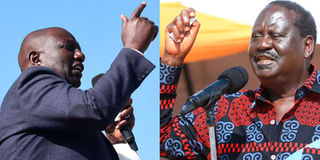Can Raila, Ruto surprise Kenyans with deputies choice?

Deputy President William Ruto (left) and ODM leader Raila Odinga.
What you need to know:
- The position of running mate is a key voter leverage because of the nature of Kenya’s politics.
- The choice is determined by what number of voters a candidate will bring if they are given that opportunity.
A year to a presidential election in the United States of America, on whose political structure we have generally modelled our own Constitution, is a very intense time for candidates interested in nomination for the presidential party ticket because they are working hard to win the party endorsement but also starting to think about the running mate and the key policy issues that will shape their campaigns. The situation here is so similar, yet so different.
Similar because the intensity is there and those considering themselves to be in the running are busy crisscrossing the country meeting potential voters and wooing them. But very different in the manner in which plans are being executed, especially as regards selection of the running mates.
There is a good reason for this. The position of running mate is a key voter leverage because of the nature of Kenya’s politics. The choice is determined by what number of voters a candidate will bring if they are given that opportunity.
Unlike in the US where there is a rigorous vetting process and interviews conducted by the main candidate, the defining characteristic here is the tribal block one comes from and the level of acceptance and influence they carry in their community.
Ultimately, that is why occupants of the Number 2 position have not had the greatest of times while serving. Their usefulness ends immediately the vote is in. Even those that may have insisted on pre-nups of sorts before signing off on the coalition have quickly found out that coalitions are very slippery.
It is not going to be different this time. Under the prevailing logic, a candidate must anchor their candidacy on an “own” tribe before they go fishing. So, Raila Odinga has the Luo while Deputy President William Ruto has the Kalenjin community. Pretenders will try to penetrate those regions but it is very very tough. Ask Kanu’s Gideon Moi, a man of considerable means who should not be humiliated the way he often is in the Rift Valley. Migori Governor Okoth Obado is the nearest you get to a gadfly in Luoland but even he has been painfully reminded that that territory is still firmly an Odinga kraal.
Mr Odinga and Mr Ruto are unlikely to innovate and do something unique like apply different criteria in choosing a running mate. They are expensing energy and resources looking at numbers (read tribes). That is why the mountain region is so crucial given the fact that there may be no presidential candidate from there.
Controversially minted
Former Cabinet secretary Mwangi Kiunjuri believes he can deputise Ruto, just as Gatundu MP Moses Kuria does. Cosying up to Raila are people like Mr Peter Kenneth, a former legislator and presidential candidate. Angling to have a say in all these is National Assembly Speaker Justin Muturi, freshly though controversially minted as the Mt Kenya region spokesman. He says he will be on the ballot. But can any of these pull the vote in their direction as deputies or as a main candidate?
From Central Kenya, the general circuit for the leaders is Coast, Western Kenya, and Lower Eastern (which is the Kamba territory).
At the Coast is a pot pourri of tribes that feel badly used by those from the mainland and a significant chunk of Luhya and Luo settlers that make the mix quite cosmopolitan. Governors from there led by Ali Hassan Joho (Mombasa) and Amason Kingi (Kilifi) are agitating for a chance to be Number 2, (or even Number 1). Though important, the fact is that as a block, the numbers they put on the table are not decisive.
The Western Kenya (Luhya) vote could make a significant difference but the community and their leaders have not wanted power sufficiently to scheme for it.
As it is, the community there is disparate and appears set to give a portion to each of the candidates, including Musalia Mudavadi, who appears determined to run.
The Kamba will also be divided among their candidates.
The Kisii, Somali and Turkanas are useful numbers to have but they are unlikely to win you the vote unless they all vote as a block, something they are so far incapable of doing.
It is possible that the leading candidates can do something really interesting? Like look for a de-tribalised youth (like Peter Kenneth did) or woman running mate whose appeal can traverse tribe and regional blocks? The youth and women combined make up the largest voting block across tribes. Can the candidates find a way of tapping into this or is it asking too much of our tribal kingpins?
The writer is a former Editor-in-Chief of Nation Media Group and is now consulting. [email protected], @tmshindi)





